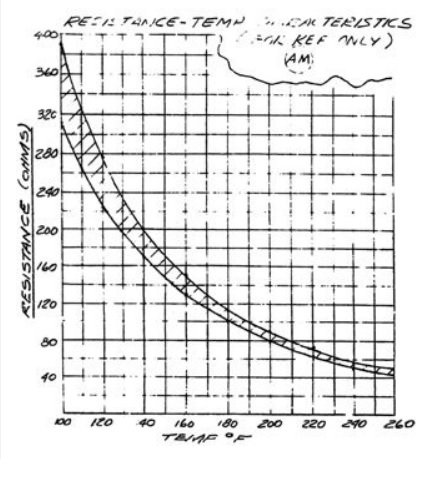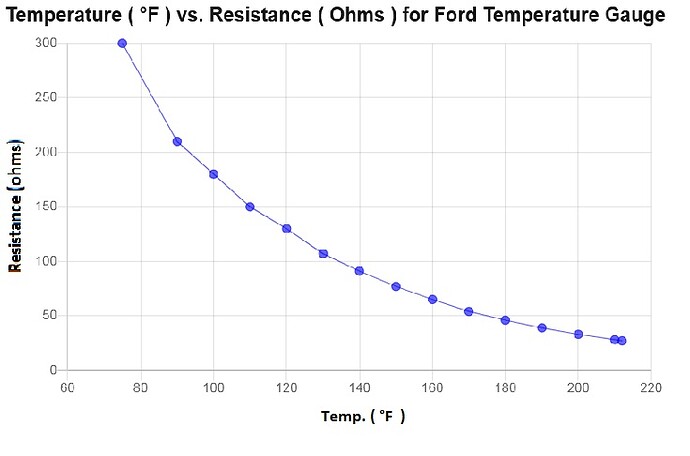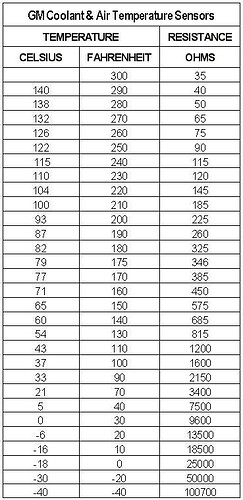Royce, The Motorcraft sender you show is the same one I installed a few weeks ago.
It changed nothing.
Post a picture of it. The ones Mansfield Mustang sells are 30 + years old. The new ones don’t have a correct value thermister hence they have no value.
The one I purchased is installed in the engine. I bought it from my local parts house a little over 2 months ago. . Can I tell by looking at it if its correct?
The one you bought has a black rubber insulator as do all of them made in the past 25+ years. The old ones have the red insulator.
Ok, so I will call Mansfield tomorrow and see if I can get the correct one. Thanks again for the great info.
Spoke with Mansfield this morning. Gentleman told me they do not have a sensor that is correctly calibrated for a 351CJ.
Right, the one indicated is as close as you will ever get.
Because EVERY Ford gauge from about 1956 to 1986 used the same internal mechanism all senders have to have very similar characteristics. All Ford engines run around 192 degrees with properly running thermostats. This means that the sender for any year any engine will electrically very similar. The terminal and shape might be slightly different.
The problem is that many reproduction senders are not the same electrically. So at 192 degrees they don’t output the correct resistance to make the gauge read in the middle.
The correct location to measure temperature is not in the radiator. It’s at the sender location. The sender is measuring coolant temperature in the engine not the radiator.
If you want to test the sender you need to measure the temperature at the sender and then measure the resistance from the output to the block. Or you can test the gauge, determine that it is correct, and let it tell you if the sender is correct. No number of replacement senders can fix an out of calibration gauge.
I measured the temperature at the sender and it was only 10 degrees difference from the water inlet at the top of the radiator. I installed a 180 degree thermostat. The coolant temp was at 183
If you are reading 183 at the sender location then that should make the gauge read just a little under half. I am thinking that you are telling us that the water inlet was 10 degrees cooler than the reading at the sender. Or if you were reading 193 at the sender and 183 at the inlet then the gauge should be in the center.
183 degrees is pretty cool. I would expect a properly working gauge to be at about 1/4 deflection - towards the cool side somewhat. A centered needle would be at 193 degrees - the thermostat is open and the engine is operating at normal temperature.
The temperature at the water neck is unimportant, the only temperature that matters is at the sending unit location.
So I pick up a new sender from Mansfield installed it and will not even move the gauge. The gauge dose not move off cold. I am thinking I will need to check the resistance of the the new sender. What would be the correct resistance reading when cold and the resistance when at operating temperature?
The resistance changes as temperature changes. So the way to test a sender is to put it a pot of water on the stove while connected to your meter. Then using a candy thermometer to measure water temp you can record the resistance at any temp. Graphing the results will give you a good idea of how each sender varies.
Given that if the sender you have just bought does not cause the gauge to register at all it’s either not grounded or bad.
Going to work on this later this week.
XR7, If when water is hot the Ohms go down to 10 then what should ohm reading be when the engine is cold?
Somewhere about 73 ohms, depending upon ambient temperature. Could be a bit lower than that if you’re in a hot area.
Thanks for the info. I have 3 sensors and they all read right around 300 Ohms at room temperature.
That’s still your problem.
From the link I provided above:
"Today I decided to do some side by side comparison testing of two temp senders I got from eBay in the past week. One is an OEM Motorcraft C6DZ 10884-B / SW552 NOS part.
The other one is a Vulcan WTV 133 which (allegedly) replaces both Ford P/N C6DZ 10884-A and C6DZ 10884-B. Needless to say I was skeptical.
I used a coffee cup and microwave oven to heat the water for each test. My 1200 watt microwave gets a coffee cup full of water to about 170 degrees after three minutes.
The ohm meter is an analog MATCO unit made by Simpson.
The water temperature gage is an analog unit made by KD Tools for testing radiator temperature.
The Motorcraft unit was at 240 ohms at 75 degree room temperature.
It climbed to 50 ohms if the water temperature was 170 degrees.
It climbed to 22 ohms at water temperature of 210 degrees. Pulling it out of the boiling water it returned to 200 ohms immediately and then to 240 ohms within 30 seconds. Movement of the ohm meter needle was very smooth in both directions."
I know this is an OLD thread, but any additional information added ( for any topic ) may be useful during someones search for a solution to a specific problem.
xr7g428 ( in Sept 2022 / in the 33 posted comment out of 38 ) mentions that graphing the Water temperature vs. Resistance would be of value in determining if your sender is functioning properly. I’ve stumbled across GM data ( graph and data table ) for their gauges, and I plotted the data for a Ford ( some of the data was taken from values provided in this thread ).
Here are the graphs and data:

From my experience, the resistance readings of the oil, water temperature, and fuel sending units range from 13 to 73 ohms (approx) for our vintage cars. All three gauges have exactly the same guts, only different faces. Now I understand circa mid-70’s, the resistance did change to much higher numbers (~300 ohms). A sending unit with a 300 ohm reading at engine temperature would likely peg the gauge.

